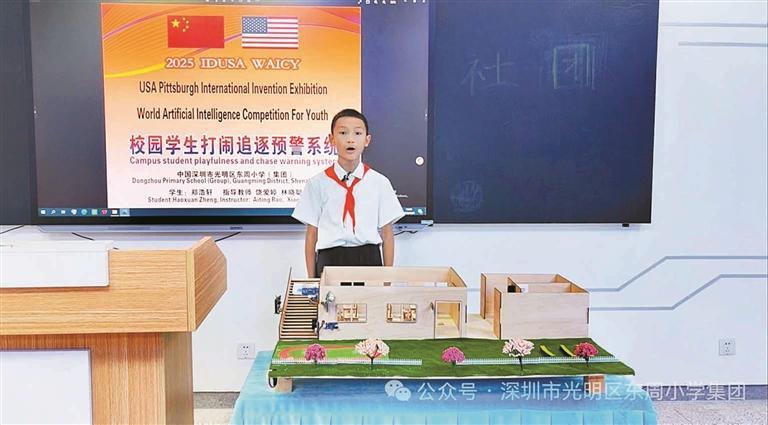
Zheng Haoxuan presents his Campus Student Playfulness and Chase Warning System.
Two young inventors from Dongzhou Primary School in Guangming District have brought home top honors from prestigious international competitions, winning gold medals at the 2025 World Artificial Intelligence Competition for Youth (WAICY) and the 2025 IDUSA Pittsburgh International Invention Exhibition.
Their victories placed them among the top teams globally in the primary school category, showcasing the strength of China’s youth innovation on the world stage, Bao'an Daily reported.
The gold-winning projects were:
The Campus Student Playfulness and Chase Warning System by student Zheng Haoxuan, guided by teachers Rao Aiting and Lin Xiaocong.
The Intelligent Management Device for Public Resources in Scenic Spots by student Liu Muyi, guided by teachers Lin Yuchen and Chen Fangjie.
The campus warning system uses an ESP32 control board integrated with ultrasonic sensors, sound sensors, visual recognition modules, and voice recognition to monitor students' movement speed, noise levels, and behavior in real time. When abnormal activity is detected, it triggers an instant alert to both students and administrators, helping prevent unsafe chasing or scuffles and strengthening campus safety.
The scenic spot management device combines touch and obstacle sensors to track the use of public facilities. When usage exceeds a set limit, the system uses a WiFi module, camera, OLED screen, MP3 module, and speaker to issue voice reminders and display available seating information, guiding visitors to share resources efficiently and making tourist site management smarter and more effective.
Dongzhou Primary's success is no accident. Since 2005, the school has pursued a vision of “nurturing future scientists from an early age,” embedding science and innovation into campus life. Its students have won seven international gold medals, three silvers, more than 50 first prizes in Ministry of Education–listed competitions, and have produced 20 “Future Innovation Stars” and 17 “Junior Academy Academicians.”




